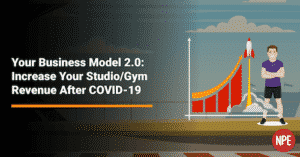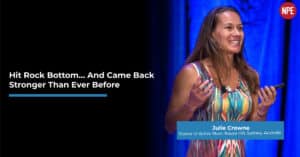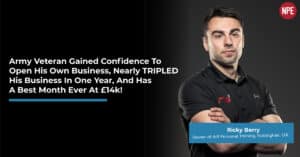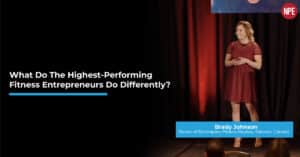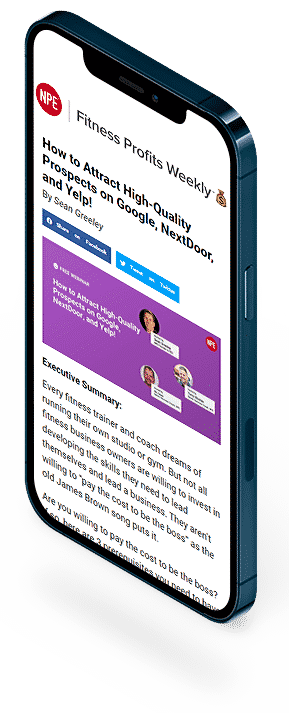How to Increase the Value You Deliver & Make Your Programs Better Than Ever: Moving from Offline to Online Part 1
By Sean Greeley
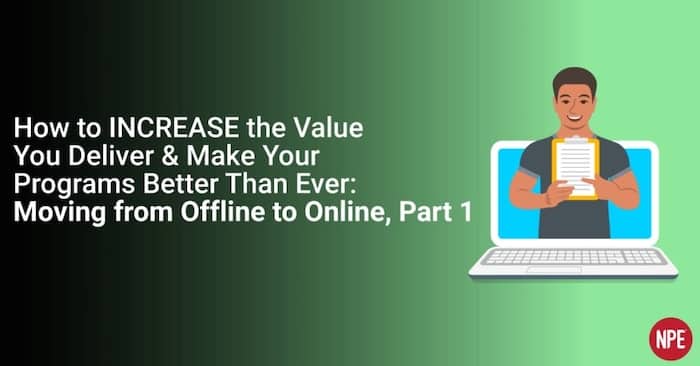
Executive Summary:
The market for fitness services has radically shifted. Clients who NEVER would have considered ONLINE services are now ready to consider the value of working with a fitness coach online. Fitness professionals and business owners who radically shift their business model will find great opportunities for success.
++++++++++++++++++++++++++++++++++++++++++++++++++++
In the last few weeks 2 events have RADICALLY shifted the course of the professional fitness industry forever.
- Government mandates have forced us to close facilities, and stay-at-home orders have made delivering services ONLINE the only option to continue serving your clients and billing/collecting revenue.
- The clients you serve who NEVER would have considered working ONLINE with you (or anyone else for that matter) are now forced to engage differently to solve their problems and achieve their goals.
In other words, both BUSINESS and THE MARKET have been forced to move in a radically new direction.
These shifts in the market create a lot of fear, worry, confusion for everyone involved… and understandably so.
The business model you had a few weeks ago, that you likely have invested YEARS in building, no longer works in this climate.
It’s like a car with a broken engine.
If you sit around, pulled off the side of the road, waiting for things to change back to the way they were (wishing your engine would just start so you can get back in the race again), you will continue to go nowhere and the race will be over for you.
I know this is difficult to process emotionally.
And it’s not easy to wrap your head around intellectually.
But the sooner you ACCEPT these circumstances as they ARE (not how you wish they were), and start thinking and working on solutions to get back in the race… then you can still finish and win!
The goal of this article (the first in a series we’ll be releasing in the next few weeks) is to guide you in the right direction to get clear on the opportunity you have right now to powerfully serve your clients and community–and take action to successfully transition your business and grow to new levels of success in the weeks ahead.
In the past month, we’ve supported more than 4,000+ fitness professionals and business owners in adapting to the new virtual world and growing their new virtual locations. People are making the transition successfully.
And we’re learning more each day from a LOT of information-sharing as we test and tweak lots of strategies and tactics to learn more about what’s working and what’s not. Here are the steps that are the most effective:
Step 1: Understand the market has shifted and ONLINE is NOT OFFLINE
You want clients who are buying from you. You want your clients who used to train with you to become raving fans again.
And you want to feel good about what you’re doing–that you’re delivering a great product that people will pay for.
But you face some challenges to achieving those goals:
- People don’t know what online training is.
- People don’t want online training. (But truth is, they didn’t want training sessions, either.)
- And you don’t know how to explain the new online service.
Plus, what you used to do offline doesn’t port directly over to online. You have to re-engineer how you deliver value to a customer.
You can’t be a trainer anymore. You have to be a coach.
The difference between the two is this:
- A trainer teaches movement and writes programming.
- A coach looks at all the factors to best serve their client, and leads them to create the outcome the client desires. The client wants to lose weight or reduce pain. A coach looks at the entire picture to lead their client to the desired outcomes.
But that’s not how many fitness business owners feel right now. Everyone wants to jump into “Just tell me, how do I get more clients?”
That won’t work.
The first step to be successful in business is to have something worthy of buying. You have to deliver tremendous value to the customer to deliver the outcomes they want.
Think of it this way: The people who love you have already made the online jump with you. The rest, on the other hand, are either on the fence or said no.
At this point, you’ve got a bunch of people who say they are not interested in online training. Now they’re not returning your calls or answering your emails!
And you’re trying to figure out what you’re going to do.
The answer is to level up the experience and the journey for your client. Commit to becoming a better coach and learn how to better engineer how you best serve customers.
You have to use this time to go from trainer to coach, and as a business owner with a team… you have to better lead and develop your trainers to the point where they are GREAT (not just ok) coaches.
Step 2: Understand people need help right now and there’s never been a better time to serve them
There has never been a better time to powerfully serve your ideal client and deliver value to them. People know the lifestyle risks of staying home, hitting the refrigerator every hour, sitting in front of a computer, and not getting proper sleep.
The opportunities to direct their energy with good leadership and coaching are there.
Success starts with understanding WHO your ideal client is and what their needs are.
Do they want to get out of pain, improve sports performance, look better, feel better, have more energy?
Whatever the outcome they want, you want to deliver it and you want to do it as efficiently as possible.
Where we’re seeing a lot of success right now with businesses that are successfully moving to ONLINE is because no matter what your avatar, you actually CAN deliver strong outcomes online.
For example, it used to be “I drive 20 minutes to the gym, do a one-hour session, and 20 minutes home.” But now there’s no commute … and there’s also less of the hang-out and banter time, so virtual sessions are often shorter. Session times that used to be an hour are now more efficient at 45 minutes.
Also, people may be eating more food, they may be drinking, not moving very much, and they’ve stopped working out. And it shows. This is the perfect time for a coach to lead them to the outcomes they want and need.
Bottom line: Know your client and their needs, and then take the next step to deliver the value stream for their services. Your job is to sell outcomes, not sell sessions and please stop trying to sell your time.
Step 3: Re-Engineer the Value Stream of Your Services
The formula we teach for value is V-CE+R+R.
Value = Client Experience + Relationships + Results.
You need to port the value you provide of EACH of these into the online world.
The customer journey is different depending on whether you are offline or online.
Relationships are more important than ever. People in isolation need relationships, support, and accountability.
For example, clients may need MORE help when they are working out from home. They may need more coaching, and more support to stay on track when they can just watch a streaming movie channel and the refrigerator is right there.
An online coaching session can seem a LIFELINE when someone is stressed from the news and isolated from others, with all the temptations to sit on the couch and do nothing.
In fact, my mother who is NOT a technology person and has never attended a virtual coaching session, now meets her fitness coach online for regular sessions. And she doesn’t miss them–the connection is crucial right now with all that is going on. Exercise and movement is a key aspect of her mental and physical health and the community she connects to.
And the way you get results is a matter of stop thinking like trainers and start delivering value like coaches. That means re-engineering your value stream to deliver in each of these areas:
- Assessing clients. What are their needs? What are their injuries? What are their goals? What are their problems? What equipment do they have access to? What can they actually do in terms of movement?
- Program design. Design the right protocols, the right movements, reps/set schemes, strength and conditioning–all the things you’re doing to do to put the right plan together to do work, to get them to their goals.
- Teaching technique. Show how to perform movements. How to have good form. How to have the right engagement with the form to get the most out of the movement.
- Accountability and support. How do we help them show up and give their best time and time again? How can we help them get the most out of it?
- Nutrition and recovery. What does that look like for them to achieve their goals?
- Community. The connection to like-minded people trying to achieve similar goals … we’re seeing that more than ever, especially when people are socially isolated at home. People are going stir crazy, and they’re looking for connections.
The percentages will slide back and forth for the individual elements, depending on the experience of the client.
For example, more experienced fitness people will strongly value program design, because it will likely be more complicated and more advanced programming designed to deliver specific outcomes. That will be where the value lies for them, and less with the hand-holding part of the session, because they have the discipline to do the work. They may also value technical form even though they know the movements; even Olympic athletes still have coaches.
Compare that to the value you will offer coaching a newbie. The program design will be simple–probably just a few movements. You don’t want to overwhelm them. Accountability and support will be more important. Hold their hand to show up … really build their confidence to execute the session. You’re going to want to coach them a lot on technique to make sure they are not going to injure themselves.
Bottom line: The value components on coaching won’t change from offline to online, but HOW much help and what type will change as you move from offline to online.
Step 4: Get to market, ask for feedback every day, and iterate like crazy
We recommend a process from the software development world called MVP. MVP stands for minimum viable product. Perfect is the enemy of the good. An MVP delivers the goods, but without all the extra bells and whistles.
For fitness professionals and business owners, that means get online as soon as you can. Then iterate, iterate, iterate.
The first session probably will not run smoothly. Address the issue directly and be prepared for Q&A and technology issues.
Get everyone comfortable. Explain how the session will run. Take attendance for the group, so everyone is acknowledged and feels like a part of the group.
Agree on a communication – thumbs up or thumbs down, different handle signals, so people can answer questions when they are out of breath. The key is align around how to get the trainers attention in a group setting.
You don’t have to be doing the workout with the client. You have a choice to demonstrate the exercise or share a recorded demo video. You want to be able to focus on their movement so you can coach them in the correct movements. (It’s helpful if you are not backed away from the camera and can actually see them.)
Give people technique reminders and breaks at normal intervals.
And wrap it up.
Make sure you communicate MORE ONLINE than you would in an in-person offline session. Vocalize your communication as much as possible.
When the session is over, ask for feedback.
This is crucial because you need to do this EVERY SESSION to make sure that you improve your service and online coaching delivery.
Each session needs to end with:
- How was the intensity of the workout for you today?
- How can we continue to improve the remote coaching experience for you?
- Would you please take 2 minutes and send me a brief message saying what you enjoyed about the remote session and why you’d recommend others engage this as well?
You want lots of feedback. You want them to tell you what was working and what was not … if no one is saying anything, you have a problem. Do not assume no feedback means no problem.
Take that feedback and use it to improve the next session.
Keep iterating, getting feedback, applying the feedback to the next session, until you get to WOW!
For example:
Feedback that shows a need for improvement: “It was pretty good.” Or people are hemming and hawing … meh. If that happens, ask them what would have to happen for this to be the best coaching ever for you.
Feedback that shows you are delivering great value: “Wow. That was great. The results I’m getting are great.” Don’t stop until you are delivering a powerfully effective coaching product online.
Only then, when you have a product WORTHY of delivering incredible value to the market (that is, it’s not just donations from loyal customers) do you attempt to reactivate clients who have paused or stopped engaging with you.
Summary
Whether we like it or not, the world has changed and the move right now is to online. You can’t think like a trainer, and you can’t just move the offline training to online. It goes behind setting up a camera. You need to re-engineer your value proposition by taking your client experience, your relationships with clients, and delivering results online. Start right away with a MVP, and then iterate and iterate until you get to WOW!
Note: This is the first of a 3-part series on adapting to the new world and moving from OFFLINE to ONLINE. Part 2 will show what the leading fitness business owners are doing to sell their new online services (and overcome I’m not interested in online training objections). Part 3 will cover marketing your services, including reactivating those clients who have paused and stopped engaging with you AND start acquiring new clients and growing through the curves.







